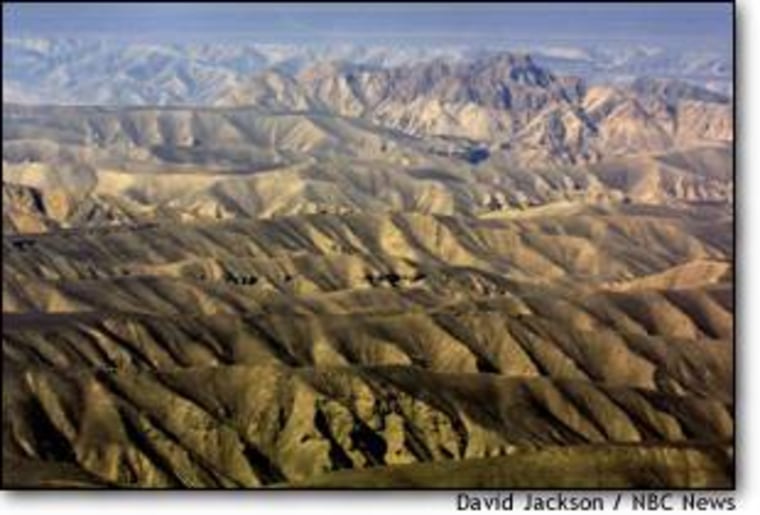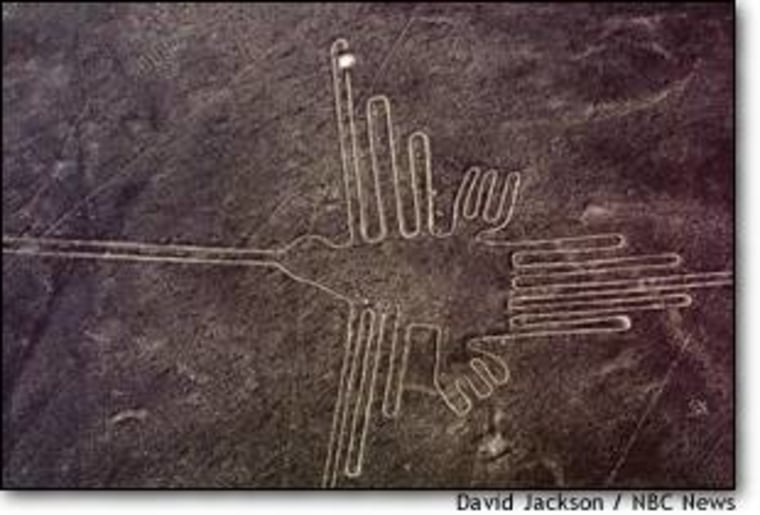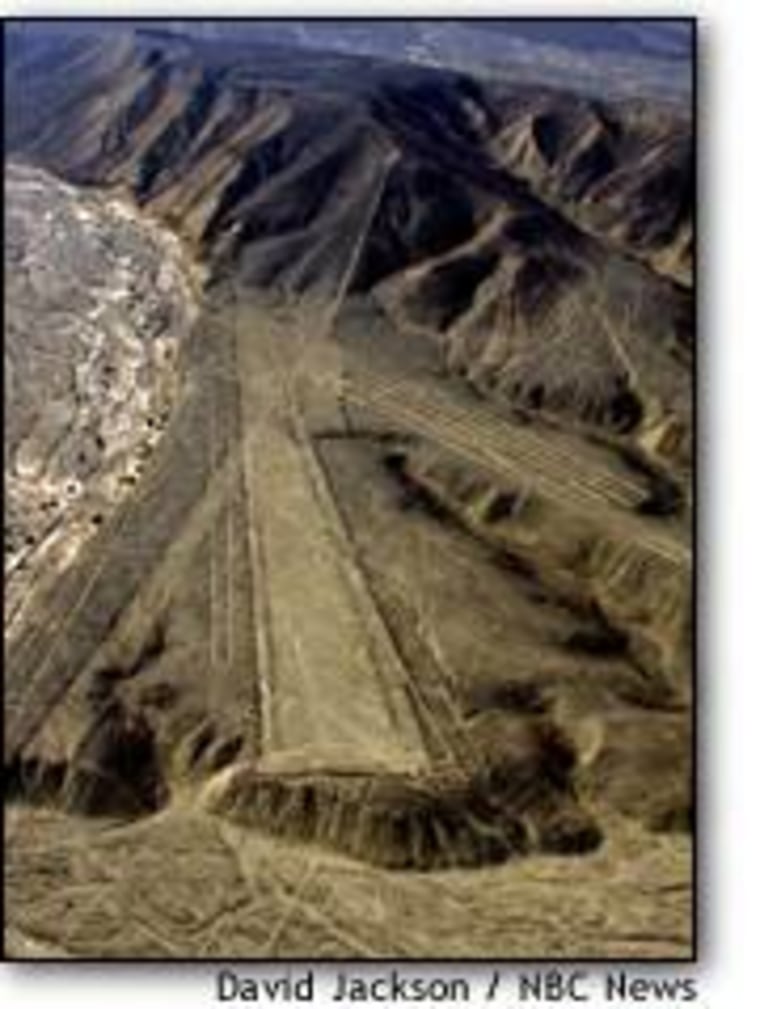We’ve spent some time talking about the mysteries surrounding the great settlement of Machu Picchu, but west of the “Lost City” of the Incas, in the desert region near the Pacific coast, lies another mystery that has endured longer than Machu Picchu’s stone structures. NBC’s Kerry Sanders reports.
IN SOUTHERN PERU, in one of the driest deserts in the world, lies a mystery more than 1,500 years old — the Nazca Lines.
“It’s a mystery. Indeed, nobody really knows who made them,” says Juan Carlos Iraola.
What has long baffled the experts: How could the Nazca people who could not fly, build what we’re about to see? Taking us up: our guide, and pilot — Juan Carlos Iraola.
Iraola: “So without a plane, without a reference from the air, there’s no way to see them.”
Kerry Sanders: “It’s a mystery?”
Iraola: “Indeed it’s a mystery.”

We take off from the lines on a runway, to the Nazca Lines, which cover more than 400-square miles, and are made up of more than 1,000 lines and trapezoids and easy-to-spot figures.
Sanders:“So what’s that over there?”
Iraola:“Well, that guy. I call it the Mexican. Some people, some of my friends call him voyager. It has a big hat. Because it has a big hat it looks like a Mariachi for me.”
Pilots flying over the desert first discovered the lines in the 1920s. Some call it the world’s largest canvas. If it is not artwork, other experts suggest a ceremonial purpose — drawn to please the gods. Some designs are simplistic, like the spiraling lines, else where, they’re more complicated, like the humming bird atop a plateau, which is a little bit larger than a football field. There’s the whale, bisected by a line. Experts believe the line was drawn hundreds of years after the whale. But why cut it in half?

The same goes for the spider — an insect not even found in this region. The closest spiders — like monkeys — are found in the Amazon, on the other side of the Andes Mountains over 700 miles away.
The late Maria Reiche — a renowned German scientist — spent more than 40 years studying the lines. She thought the lines lead to the setting sun during the summer and winter solstices. The patterns, she suggested, aligned with the stars, to create the world’s largest book of astronomy. The measurements of the lines — some more than five miles long — she said, prove the Nazca people had mastered advanced mathematics.
Reiche’s long-time friend Ana Maria Cogorno took me on a rare walk along the lines — our feet bare so as not to disturb the ground — remarkably protected by the dry desert heat and lack of rain for a thousand years. The lines, are not drawn into the desert, rather they’re an etching.
Cogorno: “Well what they did was to strip the pebbles to the side, and immediately the yellowish clay appeared.”
Sanders: “Designing the layout, simple?”
Cogorno: “Well, it’s very simple. What’s not simple and very mysterious is the way they had this abstract conception to make all the designs.”
In the late 1960s, Swedish researchers announced their analysis that Nazca was drawn by extraterrestrials. One design, they called the astronaut, whose lines they figured, were created to guide space ships.

Archaeo-astronomer Anthony Aveni has spent more than 25 years studying the Nazca Lines.
“I suppose we could wonder whether they would need a runway? If they could traverse the reaches of extra-galactic space, who needs a runway to land on? The Nazca Lines will always be an enigma. I think we’ll never know for sure what they’re real purpose or purposes was or were, but I’m really compelled toward believing that water had something to do with it,” says Aveni.
The lines in this dry desert pointing to sources of water — it’s the newest theory.
“It may not be the whole story, but water has to figure in there somewhere,” says Aveni.
Not knowing exactly what the lines mean is a big reason this is among the most visited places in Peru.
Tourists Phil Burke, and Colleen Lawn are visiting from Australia.
Lawn: “Sometimes it’s quite nice not to know everything.”
Sanders: “Nice to just have a mystery?”
Lawn: “Yes. That’s right.”
It’s a mystery that pre-dates the Inca’s — the lines and the designs, and all that they may mean, are still unclear 1,500 years after the Nazca people first began to etch them.
If you’d like to see the lines: Plan to take an early morning flight from the Nazca airfield. As the sun heats up the desert, the thermals kick in, making for a turbulent ride later in the day. There are several airlines that take tourists to see the lines, some charging as little at $30 for a short flight. The “Today” crew flew with Aero Condor (asnasca@net.telematic.com.pe). Our pilot was Juan Carlos Iraola. He’s native Peruvian who speaks English with a New Zealand accent.
NBC’s Kerry Sanders, producer Geoff Tofield, cameraman/photographer Ray Farmer and audio engineer David Jackson all contributed to this report.